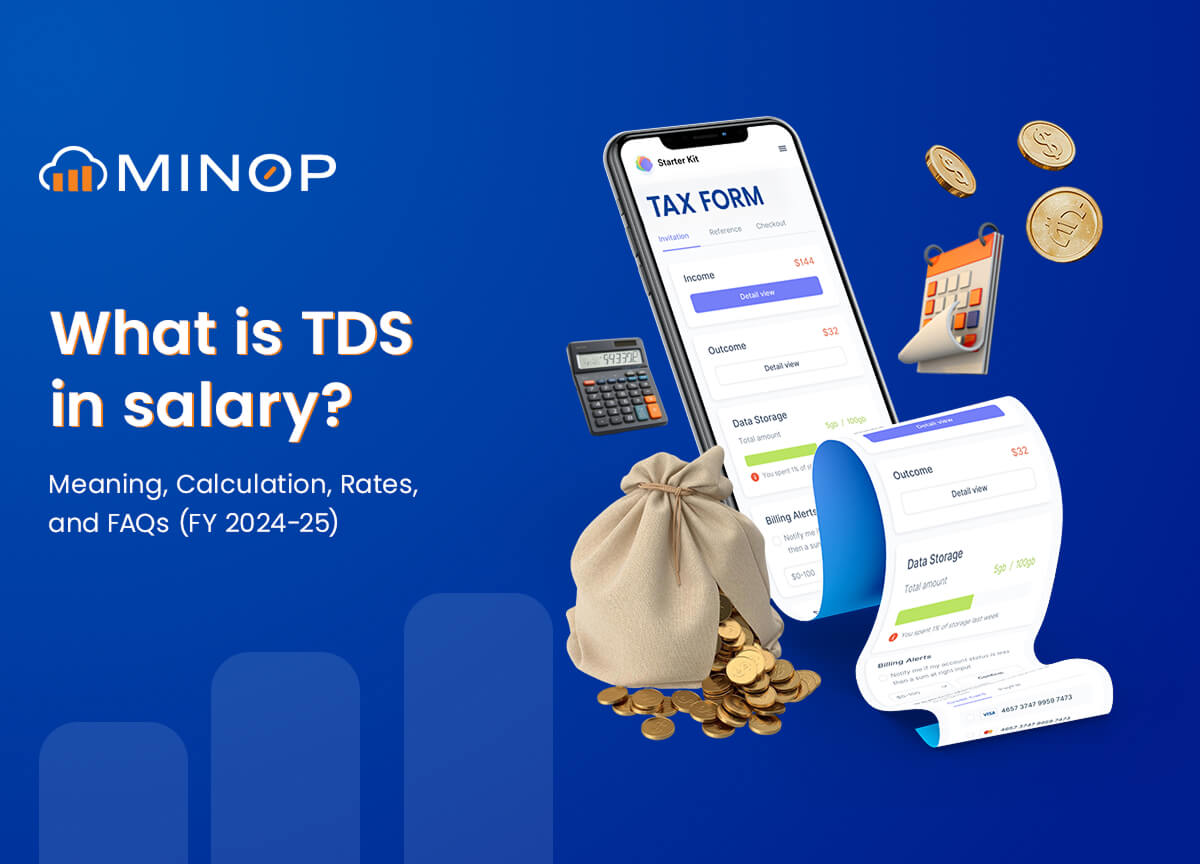What is TDS in salary? Meaning, Calculation, Rates, and FAQs (FY 2024-25)
Posted On:- 29 July, 2025 By:- Vaibhav Maniyar
Introduction
TDS is a mechanism through which the government collects income tax from your salary before it even hits your bank account. But how does this system work? Who decides how much is deducted? And where does that money go? In this blog, we unpack these questions and explore the layers behind this routine yet important deduction.
What is TDS in salary?
TDS is a form of direct tax collection implemented by the Government of India under the Income Tax Act, 1961. It operates on the principle of "pay as you earn"—similar to the withholding tax system in countries like the USA and Canada. The full form of TDS is Tax Deducted at Source.
TDS requires the deductor (typically an employer) to deduct a certain percentage of tax before making specified payments to the deductee (typically an employee) and to deposit that amount with the central government. This process ensures:
Regular inflow of revenue to the government
Prevention of tax evasion
Simplification of tax collection
Broader tax base
Definition of TDS
TDS is a mechanism in which tax is collected at the very source of income. When any person or company makes payments such as salary, interest, rent, or professional fees, and the amount exceeds prescribed thresholds, they must deduct tax at the applicable rate and deposit it with the government.

Deductor:
Person responsible for deducting TDS

Deductee:
Person receiving the payment

TAN:
Deductor must have a Tax Deduction Account Number

PAN:
Deductee must furnish their Permanent Account Number
In simple words, the employer deducts a certain portion of your earnings every month and deposits it directly with the government. The purpose is to ensure a steady inflow of tax revenue and reduce the burden of paying a lump sum at the end of the year.
So, when someone asks, "what is TDS in salary?", the answer lies in this arrangement: you earn, a part of it is withheld, and your income tax liability starts getting addressed from Day 1 of the financial year.
TDS applies regardless of payment mode (cash, cheque, or credit) and must be made at the time of payment or credit—whichever is earlier.
Did You Know?
From April 2025, banks won't deduct TDS on interest unless the annual interest exceeds ₹1 lakh for senior citizens - helpful if you're living off your savings.
Overview of TDS on Salary (Section 192)
TDS (Tax Deducted at Source) on salary is an advance income tax mechanism where your employer deducts tax from your monthly salary before paying it to you, under Section 192 of the Income Tax Act, 1961. This deduction is indeed mandatory if your estimated annual income exceeds the basic exemption limit—₹2.5 lakh in the old regime or ₹3 lakh under the new regime; as per the latest Budget 2025, this limit rises further in some cases.
At the start of each financial year, you declare your expected salary, exemptions (like HRA), deductions (80C, 80D, etc.), and any other eligible tax-saving investments to your employer. Based on this declaration, your employer computes your projected total income, calculates the tax using the applicable slab rates (depending on the regime chosen), and divides the total tax liability evenly across the year to deduct a proportionate amount each month.
Related: 5 Basic Steps In Processing Payroll
If you make additional tax-saving investments by year-end, you submit proof to the employer—your TDS for subsequent months is adjusted accordingly, and any extra deducted can be claimed as a refund while filing your ITR.
Beyond salary, TDS applies to other payments such as rent, commission, professional or technical fees, payments to contractors, and even lottery winnings—each falling under different sections with specified rates and thresholds. For example, TDS on rent now applies only if annual rent exceeds ₹6 lakh (from FY 2025-26 onward), while TDS on bank interest for senior citizens is deducted only if annual interest exceeds ₹1 lakh.
Main Features of TDS (in General and on Salary)
TDS, particularly on salary, operates under a strict compliance framework. The tax must be deducted by the employer either at the time of making payment or at the time of crediting the salary to the employee's account—whichever is earlier. Employers must obtain a unique Tax Deduction Account Number (TAN) and quote it in all TDS-related filings and communications.
After deduction, the tax must be deposited with the government by the 7th of the next month (except for March, where the deadline is notably 30th April). The employer must provide employees with Form 16 by 15th June each year, certifying the amount of salary paid and TDS deducted.
In addition, employers are required to file quarterly TDS returns detailing the amounts deducted and paid for each employee. Failure to deduct or deposit TDS on time draws penalties and interest, sometimes even exceeding the principal tax due. If an employee fails to provide a PAN, TDS has to be deducted at a higher rate of 20% under Section 206AA.
For high-income earners, not only are income tax slabs considered, but also surcharge and health & education cess are applied as per prevailing law. The net effect is that both employers and employees must stay vigilant about TDS obligations to avoid compliance setbacks and financial penalties.
What Qualifies as Salary for TDS?
For the purposes of TDS under Section 192, salary is defined broadly by Section 17(1) of the Income Tax Act. It includes much more than just monthly wages. All payments, whether received in cash or in kind, that arise from an employer-employee relationship are covered. This means your regular wages or pay, as well as any pension or annuity received from your employer, will count toward salary.
The definition also wraps in gratuity received on retirement or resignation, any fees, commissions, or perquisites (like rent-free accommodation, car facilities, or bonus shares), salary received in advance, employer's contributions to recognized provident funds, and amounts received from leave encashment or other contractual employment payments. In short, if a payment arises by virtue of employment and not as a one-off or independent arrangement, it is included while calculating TDS on salary.
What Doesn't Qualify as Salary?
Certain payments, despite seeming similar, are not treated as salary for TDS purposes. For instance, any remuneration paid to partners of a partnership firm is not salary but is instead taxed as "Profits and Gains of Business or Profession" and falls under a different section for TDS. Family pension, which is paid to the legal heirs of a deceased employee, is also excluded and is taxable as "Income from Other Sources," not salary.
Likewise, salary or allowances received by Members of Parliament (MPs) or Members of the Legislative Assembly (MLAs) are not considered "salary" in the income tax sense and are taxed under "Other Sources." These distinctions are crucial for determining both the rate of TDS and the relevant tax head.
TDS Comparison Table
Here is an updated and precise comparison table capturing the key TDS and Income Tax components under the Old vs New Regime for FY 2025-26, with information based on the latest budget updates:
| Component | Old Regime | New Regime |
|---|---|---|
| Basic Exemption | ₹2.5 lakh | ₹4 lakh (rebate up to ₹12 lakh for salaried after deduction) |
| Standard Deduction | ₹50,000 | ₹75,000 (for salaried) |
| Section 80C Benefit | Yes (up to ₹1.5 lakh and more) | No (except some specific deductions; standard deduction only) |
| Other Common Deductions | Allowed (HRA, LTA, 80D, Home Loan Interest, etc.) | Not allowed (except standard deduction, employer NPS, and family pension) |
| Income Tax Slabs | 0%: up to ₹2.5 lakh 5%: ₹2.5–5 lakh 20%: ₹5–10 lakh 30%: above ₹10 lakh | 0%: up to ₹4 lakh 5%: ₹4–8 lakh 10%: ₹8–12 lakh 15%: ₹12–16 lakh 20%: ₹16–20 lakh 25%: ₹20–24 lakh 30%: above ₹24 lakh |
| Best for | Taxpayers with significant deductions or investments | Taxpayers with minimal deductions, salaried with income up to ₹12.75 lakh (effectively zero tax after standard deduction) |
Key Insights:
The new regime now offers a higher standard deduction (₹75,000 vs ₹50,000 old) and a broad tax-free threshold through combined basic exemption plus rebate for most salaried individuals up to ₹12.75 lakh.
Only the old regime allows most traditional deductions (80C, HRA, etc.), so it's optimal for those who actively invest or have tax-saving expenditures.
The new regime is simpler and best suited for those not maximizing tax benefits through deductions, or who want lower compliance burdens and zero tax up to ₹12.75 lakh if salaried.
These rules are effective for FY 2025–26 / AY 2026–27, reflecting the Union Budget 2025 changes. Always check which category fits your actual deduction profile to minimize your effective TDS and annual tax outgo.
Related: Everything About Payroll Structure
How is TDS on Salary Calculated?
The employer must estimate the employee's total income, apply all eligible exemptions/deductions, compute the net taxable income, and then calculate the total tax liability using the applicable income tax slab.
Here's a simplified breakdown:
Your employer estimates your total annual income.
Reductions and exemptions under various sections are subtracted.
Based on the income tax slab, annual tax liability is computed.
This total is divided over the months left in the financial year and deducted from your salary.
The final taxable income is calculated.
This tax is then divided equally across the remaining months of the financial year and deducted monthly. Even income generated through illegal means (such as fabrication of TDS certificates) is still taxable. The law does not care about how income is earned - if you make money, it's taxed.
Note - While both Professional Tax and TDS involve tax deductions, they are fundamentally different in purpose and application: Professional Tax is a state-specific tax applicable to individuals practicing professions or earning a salary. TDS is a nationwide mechanism for collecting income tax at the source.
Final Thoughts
The answer to the question of what is tax deducted at source is not simple, but it's also not complex either. Remember, TDS is a cornerstone of India's tax administration system, playing a critical role in ensuring efficient, timely, and transparent tax collection
This mechanism not only helps in spreading out taxpayers' liability over the year, thereby reducing the burden of lump-sum payments during tax filing, but also acts as a deterrent against tax evasion by creating a traceable income trail.
Ultimately, TDS strengthens tax compliance by integrating tax collection into regular payment flows, aids the government in revenue predictability, and encourages honest reporting of income. Both employers and employees share the responsibility of ensuring TDS is correctly applied and tracked, helping to prevent penalties, facilitate smooth tax filing, and promote a fair, transparent tax environment.
In conclusion, TDS is a vital element of India's tax system that streamlines tax collection, supports government cash flow, curbs evasion, and requires active participation and diligence from both deductors and deductees to function effectively.
FAQs
What happens if I switch jobs mid-year?
If you change jobs during the year, your current employer is responsible for deducting TDS on your total salary earned throughout the year—not just with them. You must provide details of your previous salary and TDS deducted to your new employer (usually by submitting your last Form 16 or a salary statement). If you do not, you may end up with insufficient TDS and eventual tax liability during filing.
How is TDS calculated for non-monetary perquisites partly overseas?
Non-monetary perquisites, like a company car or accommodation, are valued as per Income Tax rules. TDS must be deducted on the combined value of monetary and non-monetary benefits, even if some salary components or perquisites are paid outside India but services are rendered in India. Both the Indian and foreign entities may be liable to deduct TDS; reporting and compliance become especially crucial in cross-border setups.
Can I claim losses from house property to reduce TDS?
Yes, you can declare losses (like a home loan interest loss) to your employer so these can be adjusted in TDS calculations. Only losses under the head 'Income from House Property' are typically allowed. For other losses (like business or capital loss), employers usually do not consider these while computing TDS.
If my investments are made only at year-end, will my TDS for earlier months be refunded?
TDS is calculated on your projected income and declarations at the start of the year. If you make investments later, you must submit proof to your employer before the final payroll closure (usually February or March). Any excess TDS already deducted can be claimed as a refund when you file your return.
What happens if TDS is not deducted on time?
Non-deduction or delayed deposit of TDS attracts interest, late fees, and penalties for the employer. It also creates issues for the employee—as credits for TDS will not appear in Form 26AS, potentially denying you the benefit when filing your return. Employees should always check their Form 26AS regularly.
Is TDS deducted even if I do not have a PAN?
Yes. If your salary exceeds the taxable limit and you have not provided a PAN, TDS is deducted at a higher rate (20%) instead of the applicable slab rate, under Section 206AA.
How is TDS adjusted if I receive arrears during the year?
TDS must be adjusted for any arrears or advance salary paid. You may claim relief under Section 89 for the additional tax arising from lumpsum receipts, provided you file Form 10E with your return.
What is the deadline for filing TDS returns on salary?
Employers must file quarterly TDS returns in Form 24Q by the due dates for each quarter. Failure to do so results in penalties. They also must issue Form 16 to employees by 15th June each year.
Can an employee challenge TDS deduction?
If your own computation differs and you believe excess TDS has been deducted, you cannot force your employer to deduct less. However, you can claim a refund of the excess amount while filing your income tax return.
Does TDS on salary apply to pension?
Yes, TDS provisions apply on taxable pension paid by employers and certain retirement benefits if they cross exemption limits. Gratuity, leave encashment, and superannuation may have separate tax treatments; ensure correct disclosure and compute taxable components accurately.

Comments